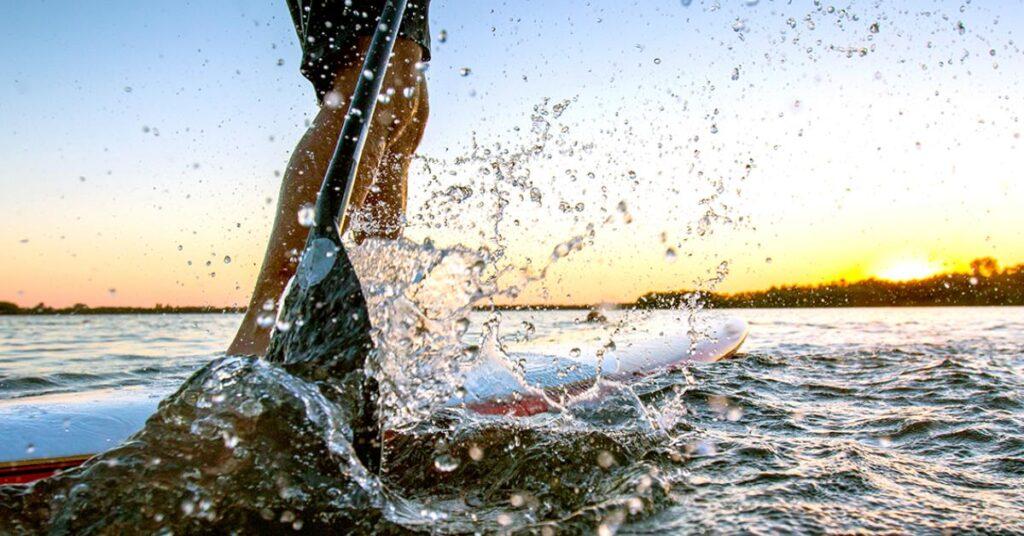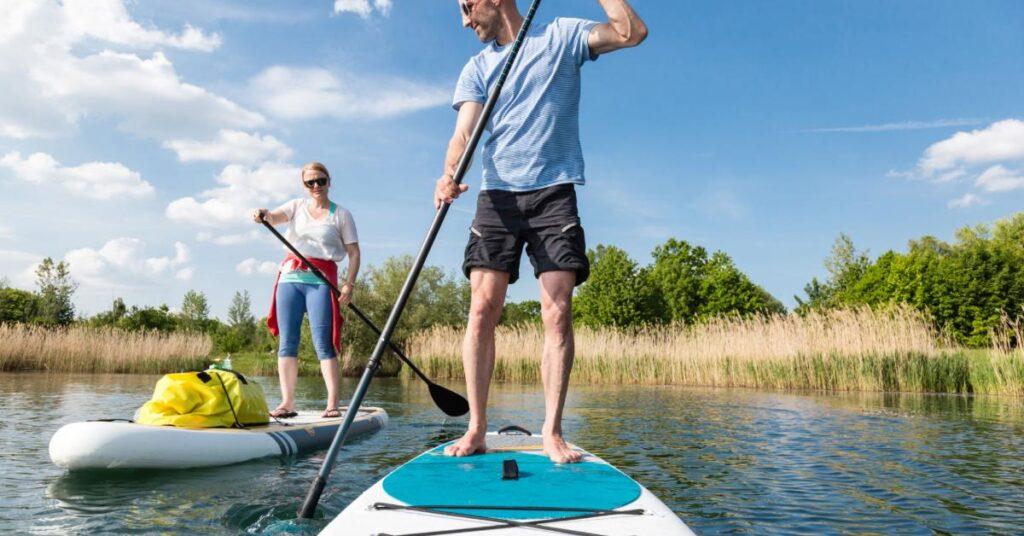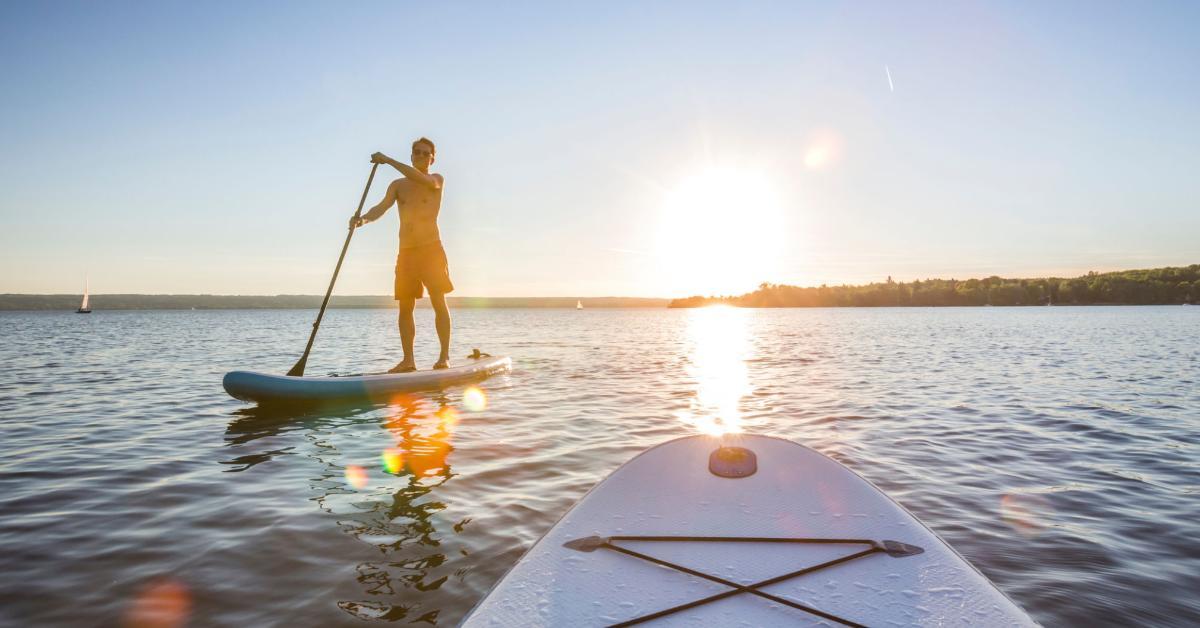Over the last few years, there’s been a major increase in the number of people who are interested in stand-up paddle boarding (also known as SUP).
There are millions of SUP participants throughout the world, and kayak retailers actually attribute between 15 and 20 percent of their total business to SUP.
Clearly, SUP is here to stay. Are you interested in joining the crowd and giving it a try?
Read on for some helpful tips that will help you to become a stand-up paddleboard pro before you know it.
What is Stand-Up Paddle Boarding?
Stand-up paddle boarding is an offshoot of the sport of paddle boarding.
Unlike paddle boarding, which involves kneeling on a board and using your arms to propel you through the water, stand-up paddle boarding requires you to (you guessed it) stand up on the paddle board and use a long paddle to help you move through the water.
Many people combine stand-up paddle boarding with other forms of exercise. For example, you can try stand-up paddle boarding while practicing yoga or Pilates. Some people fish from their board as well.

Essential Stand-Up Paddle Board Gear
When you first get started with stand-up paddle boarding, you don’t need a ton of equipment. Most people can get by fine with just the following basics:
1. Board
Of course, the first thing you need when you begin stand-up paddleboarding is a board.
Your first time or two, you can get away with renting a board. If you plan to make this a hobby, though, you ought to invest in your own.
You may want to consider an inflatable one so you can easily transport it and don’t have to worry about it taking up a ton of space.
2. Paddle
In addition to a board, you’ll also need a paddle. Make sure you choose a paddle that’s appropriate for your height. You may need to test out a few to find one that feels comfortable.
3. Life Jacket
You should always wear a life jacket when participating in SUP. The U.S. Coast Guard actually classifies stand-up paddle boards as vessels, so you have to have one on board if you’re planning to paddle outside of a designated surf or swimming area. Visit our accessories page for more.
4. Safety Whistle/Light
It’s a good idea to keep a safety whistle and/or light on board, too. Even if you’re not venturing out very far, you never know when you might need to call for help, and it’s better to be safe than sorry.
5. Leash
A leash tethers you to your board and keeps you close to the board in the event that you fall off. This can help you stay safe and avoid losing your board, which can serve as a flotation device to help you get back to the shore.
6. Clothing
You also need to make sure you have the proper clothing. If the water is warm, you’ll likely be fine wearing a bathing suit or board shorts and a rashguard. For cold waters, it’s best to wear a wetsuit for extra protection. Read our what to wear paddle boarding article here for more information.
Basic Techniques
Once you have all your gear, you can start working on mastering the basic techniques associated with stand-up paddle boarding. The following techniques will help you get comfortable on the board:
1. Standing Up
To stand up on your paddle board, start by standing next to the board in knee-deep water. Hold the edges of the board and climb onto it in a kneeling position. Aim to be right behind the center point of the board.
Once you’re comfortable in the kneeling position, place your hands on the side of the board. Then, lift one foot and then the other to place your knees.
Slowly rise to a standing position, beginning by lifting your chest and keeping the knees bent. When the chest is vertical, you can extend your legs and stand up all the way.
2. Maintaining Balance
Once you’ve stood, you need to work on staying balanced.
This is easier if you keep your feet parallel and about hip-distance apart. Keep your toes pointed forward and knees bent slightly, too.
Use your hips to shift your weight while keeping your head and shoulders steady. Let your gaze remain level instead of looking down at the board.
3. Holding the Paddle
Hold the paddle so that the blade is angled away from you and toward the nose of your board. When you paddle on the right side of the board, your left hand should be on the T-grip with your right hand a few feet below. The opposite is true when you’re paddling on the other side.
4. Strokes
The following are some basic strokes you ought to know:
- Forward Stroke: This involves moving the paddle back through the water toward your ankle and then lifting it out of the water to propel yourself forward
- Reverse Stroke: This involves moving the paddle in the opposite direction to slow yourself down or stop
- Sweep Stroke: This involves rotating your shoulders and sweep the paddle away from the board in an arc to turn it around
When you’re first getting started, work on mastering these three strokes before moving on to anything fancier.
Tips for Your First Trip
After you’ve mastered (or, at least, have started to master) the basics, you can move on and start planning your first big SUP trip.
Whether you’re heading out on a multi-day adventure or planning to spend a few hours at the lake, here are some bonus tips that will help you have a good first SUP experience:
- Consider your environment and plan your trip on a day when the weather is supposed to be nice
- Let others know where you’ll be, even if you’re only going out for a couple of hours
- Start slow with a low-stakes trip close to home
- Bring a friend so you’re not out on the water all alone
- Wear sunscreen, preferably a broad-spectrum sunscreen, to protect you from the sun’s rays
You may also want to consider joining a tour or group excursion for your first SUP experience. This will give you a chance to get guidance from an expert and surround yourself with other beginners.
Check out the best places to paddle board in San Diego.
Try Stand-Up Paddle Boarding Today

Now that you know more about SUP and how to get started with it, are you ready to dive in and give it a try?
Keep this information in mind, from choosing a stand-up paddle board to planning your first outing, and you’ll have a great first experience. No matter how many times you fall at first, you’ll love getting out on the water and trying something new.
Do you want to learn more about SUP? Do you need to purchase some inflatable gear to get started with this new hobby?
If so, check out our online store today to learn more about our products or order your own.

